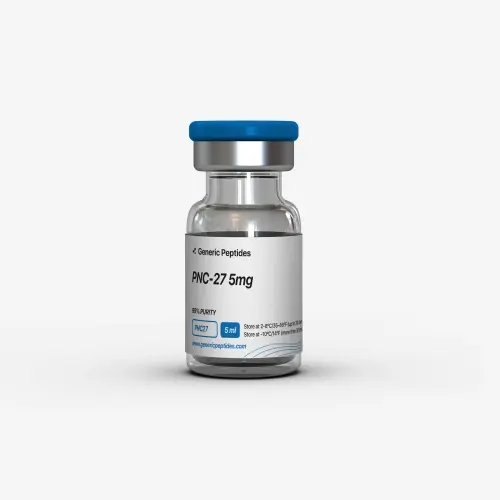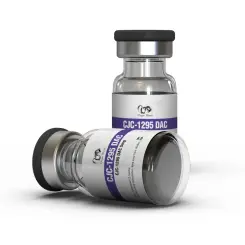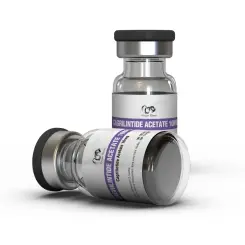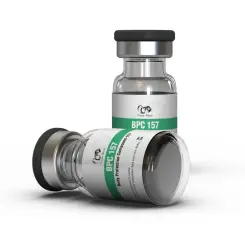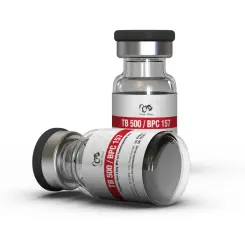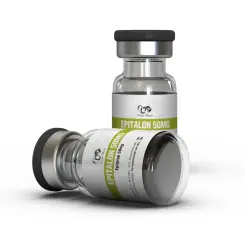PNC-27
- Targets cancer cell membranes.
- Induces selective cancer cell death.
- Supports experimental oncology research.
- Enhances understanding of cancer therapies.
What is the PNC-27 Peptide Used for?
PNC-27 5 mg is used in experimental research to investigate its ability to target and kill cancer cells by disrupting their membranes, particularly in studies involving solid tumors. It is not approved for clinical use and is intended solely for laboratory or research purposes, requiring reconstitution before application.
What is the Half-Life of PNC-27?
The half-life of PNC-27 5 mg is approximately 6-8 hours in experimental models, though this can vary based on administration method, metabolism, and research conditions. Its relatively short duration necessitates frequent dosing in studies, with detectable levels diminishing within 24-48 hours depending on the system.
Is PNC-27 Safe?
PNC-27 5 mg is not established as safe for human use, as it is intended solely for research purposes. Potential risks in experimental settings include injection site reactions or systemic effects, with safety data limited to preclinical studies. Use is strictly for laboratory research under professional supervision, and it should not be used by individuals without medical oversight.
How Does PNC-27 Work?
PNC-27 5 mg works by binding to HDM-2 protein on cancer cell membranes, forming pores that lead to cell lysis and death, while sparing healthy cells. This mechanism, derived from the p53 protein, targets malignant cells specifically, making it a focus of cancer research for potential therapeutic development.
How Long Does PNC-27 5 mg Stay in Your System?
PNC-27 has a half-life of approximately 6-8 hours, with its effects waning within 24-48 hours in experimental models, depending on dosage, administration route, and metabolic factors. Researchers should monitor clearance through appropriate assays, and professional guidance is advised for precise timelines.
Mechanism of Action PNC-27 5 mg
PNC-27 binds to HDM-2 on cancer cell membranes, inducing pore formation and subsequent cell lysis, a process selective to malignant cells due to their unique membrane composition. This action mimics p53 tumor suppression, offering a targeted approach in research settings. Effects begin rapidly and are studied over short durations. What doesn't happen: no broad systemic impact, but monitoring is essential.
How It Works & Key Benefits
PNC-27 5 mg excels for researchers exploring cancer therapies, requiring controlled lab conditions to maximize its experimental potential.
- Targets cancer cell membranes.
- Induces selective cancer cell death.
- Supports experimental oncology research.
- Enhances understanding of cancer therapies.
- Delivers rapid membrane disruption.
- Stacks with other research peptides for study.
Who It's For & Product Specifications
Best for researchers in oncology or peptide studies; intended for laboratory use only, not for human consumption. Not recommended for personal use or those without research credentials.
| Substance | PNC-27 Anti-Cancer Peptide |
|---|---|
| Concentration | 5 mg |
| Form | Vial (requires reconstitution) |
| Pack Size | Vial |
| Half-life | ~6-8 hours |
| Aromatization/Hepatic | Non-applicable / Minimal hepatic |
| Primary Use | Cancer research |
| Manufacturer | Generic Peptides |
| Brand | PNC-27 |
How to Take PNC-27 5 mg
- Dosage: Research use only; follow lab protocol (typically 10-50 mcg/ml in cell cultures or animal models); not for human dosing.
- Frequency: As per experimental design, often daily or as needed in studies.
- Cycle length: Determined by research objectives; discontinue if unexpected reactions occur.
- Preparation/Monitoring tips: Reconstitute with 1-2 ml Bacteriostatic Water using a sterile syringe (22-25 gauge), handle in a controlled lab environment; monitor cell viability and assay results; use protective equipment.
- Results timeline: Effects on cancer cells observed within hours in vitro; study-specific.
- PCT timing: Not applicable; for research use only.
Popular Stacks
PNC-28: Complements anti-cancer research.
IGF-1 LR3: May contrast growth vs. cancer effects.
TB-500: Supports tissue studies.
Cycle Support: Ensures lab safety protocols.
Comparisons & Alternatives
PNC-27 5 mg vs PNC-28: Both target cancer; PNC-27 is more studied.
PNC-27 5 mg vs Cisplatin: PNC-27 is peptide-based; Cisplatin is a chemo drug.
PNC-27 5 mg vs Taxol: PNC-27 targets membranes; Taxol affects microtubules.
Side Effects & Risk Management
- Lab-related: Irritation from handling—use gloves, ventilate area.
- Experimental: Unpredictable cell responses—monitor closely in assays.
- Other: Contamination risk—sterilize equipment thoroughly.
Consult a research professional to ensure safe handling and monitor experimental outcomes.
FAQ
What is the PNC-27 peptide used for?
PNC-27 is used for cancer research; see What is the PNC-27 Peptide Used for. For lab use only—consult professionals.
What is the half-life of PNC-27?
It has a 6-8 hour half-life; see What is the Half-Life of PNC-27. Study-specific—consult professionals.
Is PNC-27 safe?
Not for human use, for research only; see Is PNC-27 Safe. Handle with care—consult professionals.
How does PNC-27 work?
It kills cancer cells via membrane disruption; see How Does PNC-27 Work. Research use only—consult professionals.
Related Products
- Boosts growth hormone for enhanced muscle recovery.
- Promotes lean muscle growth and fat loss.
- Improves sleep quality and overall vitality.
- Supports long-term performance with minimal dosing.
- Reduces appetite for easier calorie control.
- Promotes significant fat loss for a lean physique.
- Enhances metabolic health and blood sugar stability.
- Supports sustainable weight management with minimal side effects.
- Speeds up muscle and tendon recovery post-injury.
- Reduces inflammation for faster healing.
- Enhances joint and tissue resilience for intense training.
- Supports gut health and systemic recovery.
- Accelerates muscle and tendon repair for quick recovery.
- Reduces inflammation systemically and locally.
- Enhances joint and tissue resilience for intense training.
- Supports comprehensive healing for uninterrupted performance.
- Enhances cellular repair and longevity via telomerase.
- Supports improved energy and overall vitality.
- Promotes better sleep and stress resilience.
- Boosts recovery for sustained performance.
